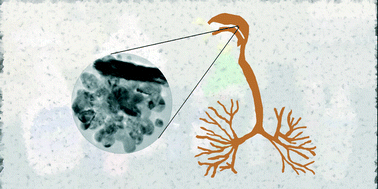Quantitative assessment of inhalation exposure and deposited dose of aerosol from nanotechnology-based consumer sprays†
Abstract
This study provides a quantitative assessment of inhalation exposure and deposited aerosol dose in the 14 nm to 20 μm particle size range based on the aerosol measurements conducted during realistic usage simulation of five nanotechnology-based and five regular spray products matching the nano-products by purpose of application. The products were also examined using transmission electron microscopy. In seven out of ten sprays, the highest inhalation exposure was observed for the coarse (2.5–10 μm) particles while being minimal or below the detection limit for the remaining three sprays. Nanosized aerosol particles (14–100 nm) were released, which resulted in low but measurable inhalation exposures from all of the investigated consumer sprays. Eight out of ten products produced high total deposited aerosol doses on the order of 101–103 ng kg−1 bw per application, ~85–88% of which were in the head airways, only <10% in the alveolar region and <8% in the tracheobronchial region. One nano and one regular spray produced substantially lower total deposited doses (by 2–4 orders of magnitude less), only ~52–64% of which were in the head while ~29–40% in the alveolar region. The electron microscopy data showed nanosized objects in some products not labeled as nanotechnology-based and conversely did not find nano-objects in some nano-sprays. We found no correlation between nano-object presence and abundance as per the electron microscopy data and the determined inhalation exposures and deposited doses. The findings of this study and the reported quantitative exposure data will be valuable for the manufacturers of nanotechnology-based consumer sprays to minimize inhalation exposure from their products, as well as for the regulators focusing on protecting the public health.


 Please wait while we load your content...
Please wait while we load your content...